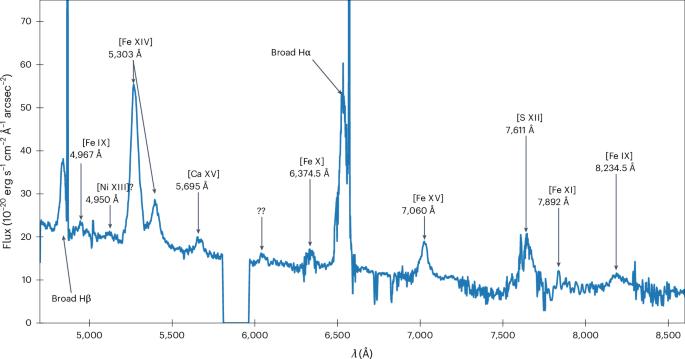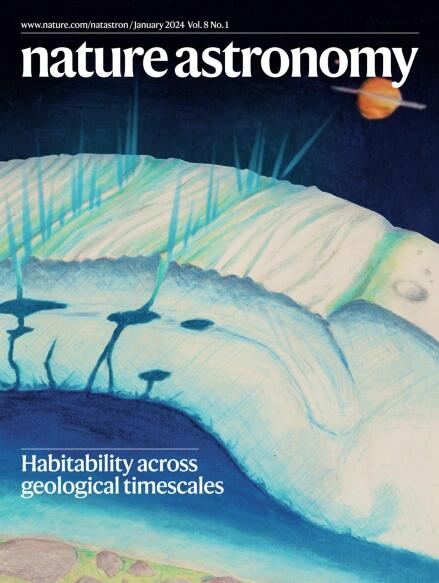Calcium in a supernova remnant as a fingerprint of a sub-Chandrasekhar-mass explosion
IF 14.3
1区 物理与天体物理
Q1 ASTRONOMY & ASTROPHYSICS
引用次数: 0
Abstract
Type Ia supernovae play a fundamental role as cosmological probes of dark energy and produce more than half of the iron in our Galaxy. Despite their central importance, a comprehensive understanding of their progenitor systems and triggering mechanism is still a long-standing fundamental problem. Here we present high-resolution integral field spectroscopic observations of the young supernova remnant SNR 0509-67.5 in the Large Magellanic Cloud. We uncover a double-shell morphology of highly ionized calcium [Ca XV] and a single shell of sulphur [S XII], observed in the reverse shocked ejecta. Our analysis reveals that the outer calcium shell originates from the helium detonation at the base of the outer envelope, while the inner shell is associated with the carbon–oxygen core detonation. This morphological distribution of intermediate-mass elements agrees qualitatively with the predicted signature of the double detonation of a sub-Chandrasekhar-mass white dwarf from a hydrodynamical explosion simulation. Our observations reveal two distinct, spatially separated peaks in surface brightness of [Ca XV] from the supernova remnant phase, providing substantial evidence that sub-Chandrasekhar-mass explosions through the double-detonation mechanism could occur in nature. They also highlight the importance of remnant tomography in understanding explosion mechanisms from the remnant phase. Observations of the young supernova remnant SNR 0509-67.5 in the Large Magellanic Cloud reveal concentric shells of ionized calcium and sulfur that resemble hydrodynamical simulations of the double detonation of a sub-Chandrasekhar-mass white dwarf.


超新星遗迹中的钙作为次钱德拉塞卡质量爆炸的指纹
Ia型超新星作为暗能量的宇宙探测器发挥着重要作用,并产生了银河系中一半以上的铁。尽管它们具有重要的中心意义,但全面了解它们的起源系统和触发机制仍然是一个长期存在的根本问题。在这里,我们展示了大麦哲伦星云中年轻超新星遗迹SNR 0509-67.5的高分辨率积分场光谱观测结果。我们发现了在反向激波喷射中观察到的高电离钙[Ca XV]和硫[S XII]的双壳形态。我们的分析表明,外层钙壳起源于外层包膜底部的氦爆炸,而内层壳与碳氧核心爆炸有关。这种中等质量元素的形态分布与流体动力学爆炸模拟预测的次钱德拉塞卡质量白矮星的双重爆炸特征在质量上一致。我们的观测揭示了超新星遗迹阶段[Ca XV]的两个明显的、空间分离的表面亮度峰,这为通过双重爆炸机制发生的次钱德拉塞卡质量爆炸在自然界中可能发生提供了实质性的证据。他们还强调了残层析成像在从残相理解爆炸机制方面的重要性。
本文章由计算机程序翻译,如有差异,请以英文原文为准。
求助全文
约1分钟内获得全文
求助全文
来源期刊

Nature Astronomy
Physics and Astronomy-Astronomy and Astrophysics
CiteScore
19.50
自引率
2.80%
发文量
252
期刊介绍:
Nature Astronomy, the oldest science, has played a significant role in the history of Nature. Throughout the years, pioneering discoveries such as the first quasar, exoplanet, and understanding of spiral nebulae have been reported in the journal. With the introduction of Nature Astronomy, the field now receives expanded coverage, welcoming research in astronomy, astrophysics, and planetary science. The primary objective is to encourage closer collaboration among researchers in these related areas.
Similar to other journals under the Nature brand, Nature Astronomy boasts a devoted team of professional editors, ensuring fairness and rigorous peer-review processes. The journal maintains high standards in copy-editing and production, ensuring timely publication and editorial independence.
In addition to original research, Nature Astronomy publishes a wide range of content, including Comments, Reviews, News and Views, Features, and Correspondence. This diverse collection covers various disciplines within astronomy and includes contributions from a diverse range of voices.
 求助内容:
求助内容: 应助结果提醒方式:
应助结果提醒方式:


